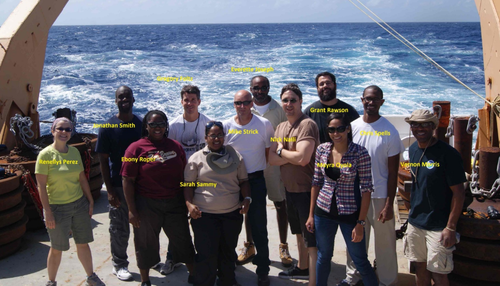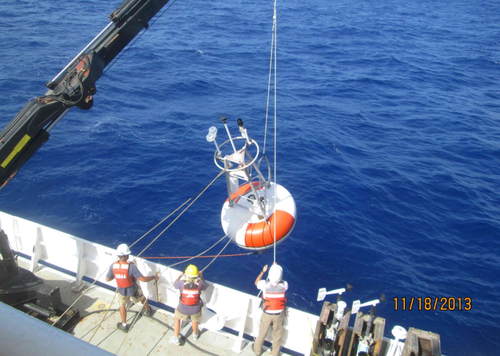PhOD Researchers on the PIRATA Northeast Extension cruise
Researchers from the Physical Oceanography Division of AOML participated in a tropical Atlantic cruise beginning in November to collect oceanographic and atmospheric data and service five surface moorings, in support of the Prediction and Research Moored Array in the Tropical Atlantic (PIRATA) Northeast Extension project (PNE).

Participants in the November-December 2013 PIRATA Northeast Extension cruise. Not shown are Shaun Dolk (AOML), Everette Joseph (AEROSE), Elsa Castillo (AEROSE), and Malgorzata Szczodrak (RSMAS).
The 2013 PNE cruise departed Bridgetown, Barbados on November 11 aboard the NOAA ship Ronald H. Brown and concluded in Recife, Brazil on December 8. Running of the cruise and collection of hydrographic data were accomplished by an PhOD team of four: Gregory Foltz (Chief Scientist), Renellys Perez, Grant Rawson, and Shaun Dolk. A technician from Pacific Marine Environment Laboratory (PMEL) oversaw the mooring recovery and deployment operations, and a scientist from the University of Miami's Rosenstiel School of Marine and Atmospheric Science (RSMAS) acquired ocean skin temperature and infrared radiation measurements. The Aerosols and Ocean Science Expeditions (AEROSE) group, composed by researchers from NOAA's National Environmental Satellite, Data, and Information Service (NESDIS) and from Howard University, collected atmospheric measurements throughout the cruise.

Michael Strick from PMEL (right) and two members of the Brown's deck crew deploy a TFlex mooring near 20°N, 38°W during the PIRATA Northeast Extension cruise.
The PhOD team measured temperature, salinity, pressure, velocity, and dissolved oxygen concentration in the upper 1500 m of the ocean from 69 conductivity-temperature-depth (CTD) casts. In addition to the standard measurements from CTD casts, special emphasis was placed on resolving the vertical structure of currents in the upper 100 m of the ocean. To accomplish this goal, the AOML team increased the vertical resolution of the upward-looking Acoustic Doppler Current Profiler (ADCP) attached to the CTD frame and the downward-looking ADCP mounted on the ship's hull. With the help of PMEL technicians, PhOD researchers also mounted two single-depth current meters on the 4°N, 23°W PNE mooring at depths of 5 m and 20 m to augment measurements from the existing current meter at 10 m. Quantification of the upper-ocean vertical structure of currents is important for understanding the role of the ocean in sea surface temperature and salinity variability. PhOD researchers also deployed two Argo floats and 20 drifting buoys, which continue to provide temperature, salinity, and surface currents data via real-time satellite transmission, and 96 eXpendable BathyThermograph (XBT) probes near selected CTD stations, with the goal of improving XBT technology.
Meteorological observations of aerosols, ozone, and atmospheric conditions were also collected by the AEROSE team during the 2013 PNE cruise. These data are being used to investigate the effect of the Saharan air layer on the marine boundary layer, clouds, precipitation, and the surface radiation balance. In addition, researchers from RSMAS mounted a Marine-Atmosphere Emitted Radiance Interferometer (M-AERI) instrument on the bow of the ship to measure surface infrared radiation and ocean skin temperature. The data will be used to improve our understanding of the surface radiation balance and to interpret satellite-based measurements of sea surface temperature.
The wealth of oceanic and atmospheric data collected during the PNE cruise, and measurements that continue to be collected from five PIRATA moorings and surface drifters, are important components of the global ocean observing system that will be used in climate studies and for operational weather, ocean, and climate forecasting.